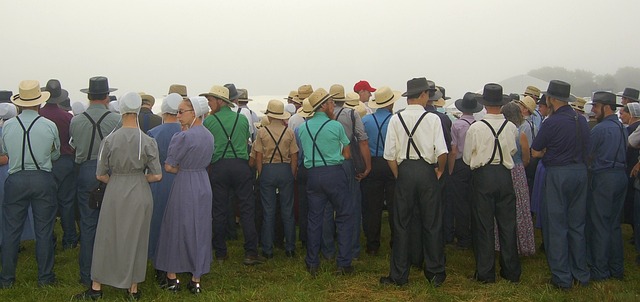The Amish are a religious group known for their traditional way of life and adherence to simple living. One aspect of their lifestyle that often raises questions is their approach to modern amenities. In this context, it is natural to wonder about their use of toilets.
Table of Contents
Traditional Bathroom Practices of the Amish Community
Do Amish people use toilets? It’s a question that many people have when they think about the traditional lifestyle of the Amish community. The Amish are known for their simple way of life, which includes living without many modern conveniences. But when it comes to bathroom practices, how do they handle it?
In the Amish community, the use of modern toilets is not common. Instead, they rely on outhouses or privies for their bathroom needs. These structures are typically located a short distance away from the main house and are used by both men and women. Outhouses are simple, small buildings that contain a hole in the ground for waste disposal. They are often made of wood and have a basic design that blends in with the surrounding landscape.
Using an outhouse may seem like a primitive practice to some, but for the Amish, it is a way of life that they have embraced for generations. It is a reflection of their commitment to simplicity and self-sufficiency. Outhouses require minimal maintenance and do not rely on electricity or running water, making them a practical choice for the Amish community.
While the use of outhouses is the norm, there are some Amish households that have adopted modern bathroom facilities. This is especially true in communities where there is a greater acceptance of certain modern conveniences. However, even in these cases, the Amish often opt for more basic versions of modern toilets. These toilets may not have all the bells and whistles that we are accustomed to, but they still serve the purpose of waste disposal.
The decision to use or not use modern toilets is a personal one for each Amish family. It is influenced by their beliefs, traditions, and the level of acceptance within their community. Some Amish families may choose to use modern toilets for convenience or health reasons, while others may prefer to stick to the traditional outhouse.
In addition to the use of outhouses or modern toilets, the Amish also have specific practices when it comes to personal hygiene. They believe in cleanliness and take care to wash their hands thoroughly after using the bathroom. This is done using a basin and pitcher of water, as running water is not typically available in Amish homes. The water is poured over the hands, and soap is used to ensure proper cleanliness.
It’s important to note that while the Amish may have different bathroom practices than the average person, they still prioritize cleanliness and hygiene. Their way of life may be different, but they still take care to maintain personal cleanliness and ensure that waste is disposed of properly.
So, do Amish people use toilets? The answer is not a simple yes or no. While the use of outhouses is common in the Amish community, there are some households that have adopted more basic versions of modern toilets. Ultimately, the decision to use traditional or modern bathroom facilities is a personal one for each Amish family, influenced by their beliefs and the level of acceptance within their community. Regardless of their choice, the Amish prioritize cleanliness and hygiene, ensuring that waste is disposed of properly and hands are washed thoroughly.
Understanding the Amish Approach to Sanitation

Do Amish people use toilets? It’s a question that many people have when they think about the Amish way of life. The Amish are known for their simple and traditional lifestyle, and their approach to sanitation is no exception. While they may not use modern plumbing systems like most of us do, they do have their own unique methods for handling waste.
In Amish communities, outhouses are a common sight. These simple structures are used as a place for individuals to relieve themselves. Outhouses are typically located a short distance away from the main house, providing privacy and a sense of separation from the living quarters. They are often built with basic materials such as wood and have a simple hole in the ground for waste disposal.
The use of outhouses is a practical choice for the Amish. It allows them to maintain their traditional way of life while still meeting their basic needs. Outhouses are relatively easy to construct and maintain, making them a cost-effective solution for waste management. Additionally, they are environmentally friendly, as waste can be composted and used as fertilizer for gardens and crops.
While outhouses are the primary method of waste disposal for the Amish, they also make use of other sanitation practices. For example, many Amish homes have a separate washroom area where individuals can wash their hands and face. This area typically includes a basin and a pitcher of water, allowing individuals to clean themselves without the need for running water.
In addition to outhouses and washrooms, the Amish also have their own methods for dealing with waste from animals. Many Amish families keep livestock, such as cows and horses, and the waste from these animals needs to be managed. One common practice is to use a manure pit, where animal waste is collected and stored. This waste can then be used as fertilizer for fields and gardens, providing a sustainable solution for waste management.
It’s important to note that while the Amish may not use modern plumbing systems, they still prioritize cleanliness and hygiene. They understand the importance of maintaining a clean living environment and take steps to ensure that waste is properly managed. This includes regular cleaning and maintenance of outhouses and washrooms, as well as proper disposal of animal waste.
In conclusion, while the Amish may not use toilets in the same way that most of us do, they have their own methods for handling waste. Outhouses are a common sight in Amish communities, providing a simple and practical solution for waste disposal. Additionally, the Amish have their own methods for managing waste from animals, such as using manure pits. Despite their traditional approach to sanitation, the Amish still prioritize cleanliness and hygiene, taking steps to ensure that waste is properly managed. So, the next time you wonder if Amish people use toilets, remember that they have their own unique methods for handling waste that align with their simple and traditional way of life.
Exploring the Amish Lifestyle: Toilets and Hygiene
Do Amish people use toilets? It’s a question that many people have when they think about the Amish lifestyle. The Amish are known for their simple way of life, living without many modern conveniences. But when it comes to something as basic as using the bathroom, do they stick to their traditional ways or do they make some exceptions?
To understand the Amish approach to toilets, it’s important to first understand their overall lifestyle. The Amish believe in living a life that is separate from the world around them. They strive to live a simple and humble existence, focusing on their faith and community. This means that they often reject modern technology and conveniences that they believe would distract them from their spiritual journey.
When it comes to toilets, the Amish do use them, but they typically opt for more traditional and low-tech options. Many Amish households have outhouses or privies, which are small structures located outside of the main house. These outhouses are simple and basic, often consisting of a small wooden structure with a hole in the ground. They provide a private and sanitary place for the Amish to take care of their bathroom needs.
In addition to outhouses, some Amish households also use composting toilets. These toilets are designed to break down waste through natural processes, such as decomposition and evaporation. They are a more environmentally friendly option, as they do not require water or electricity to operate. Composting toilets are often used in off-grid or rural settings, making them a suitable choice for the Amish who live in more remote areas.
While the Amish do use toilets, it’s important to note that they do not typically have indoor plumbing. This means that they do not have running water in their homes, and therefore do not have traditional flush toilets. Instead, they rely on alternative methods for obtaining water, such as wells or hand pumps. This lack of indoor plumbing is a deliberate choice, as the Amish believe that it helps to maintain their simple and self-sufficient way of life.
In terms of hygiene, the Amish place a strong emphasis on cleanliness. They believe that cleanliness is a reflection of their spiritual well-being, and therefore take great care in maintaining personal hygiene. While they may not have the same modern amenities as others, such as hot showers or electric toothbrushes, they still prioritize cleanliness in their daily routines.
The Amish typically wash their hands and face regularly, using water from a basin or pitcher. They also use traditional methods for bathing, such as sponge baths or washcloths. While these methods may seem old-fashioned to some, they are effective in keeping the Amish clean and hygienic.
In conclusion, while the Amish do use toilets, they do so in a way that aligns with their simple and traditional lifestyle. Outhouses and composting toilets are common in Amish households, providing a basic and sanitary solution for their bathroom needs. While they may not have the same modern conveniences as others, the Amish still prioritize cleanliness and hygiene in their daily routines. So, the next time you wonder if Amish people use toilets, the answer is yes, but in a way that reflects their unique way of life.
Toilet Habits in Amish Culture: A Closer Look
Do Amish people use toilets? It’s a question that many people have wondered about when it comes to this unique and traditional community. The Amish are known for their simple way of life, which includes eschewing modern conveniences and technology. But what about something as basic as a toilet? Let’s take a closer look at the toilet habits in Amish culture.
To understand the Amish approach to toilets, it’s important to first understand their overall lifestyle. The Amish believe in living a simple and self-sufficient life, separate from the modern world. They value hard work, community, and a deep connection to nature. This means that they often reject modern conveniences that they believe would disrupt their way of life.
When it comes to toilets, the Amish typically do not use the same type of flush toilets that most of us are familiar with. Instead, they often use outhouses or privies. These are small, simple structures located outside of their homes, usually a short distance away. Outhouses are essentially a small building with a hole in the ground, where waste is deposited. Some Amish communities may also use composting toilets, which are designed to break down waste naturally.
The use of outhouses or privies is not just a practical choice for the Amish, but also a reflection of their values. By using these simple and traditional methods, they are able to maintain their connection to the land and live in harmony with nature. It also reinforces their commitment to simplicity and self-sufficiency.
While the use of outhouses may seem outdated to some, it’s important to remember that the Amish have their own unique way of life. They have chosen to live apart from modern society and embrace a simpler way of doing things. For them, using an outhouse is not seen as a burden or inconvenience, but rather as a way to stay true to their beliefs and values.
It’s also worth noting that not all Amish communities use outhouses exclusively. Some may have access to modern toilet facilities, particularly in public places such as schools or businesses. However, even in these cases, the Amish may still prefer to use outhouses in their own homes.
So, do Amish people use toilets? Yes, they do, but in a different way than most of us are accustomed to. They often use outhouses or privies, which are simple structures located outside of their homes. This choice reflects their commitment to simplicity, self-sufficiency, and a connection to nature. While it may seem unconventional to some, it’s important to respect and understand the Amish way of life, even when it comes to something as basic as a toilet.
Conclusion
Yes, Amish people use toilets, but their use of technology and modern conveniences may vary depending on their specific community and beliefs.



